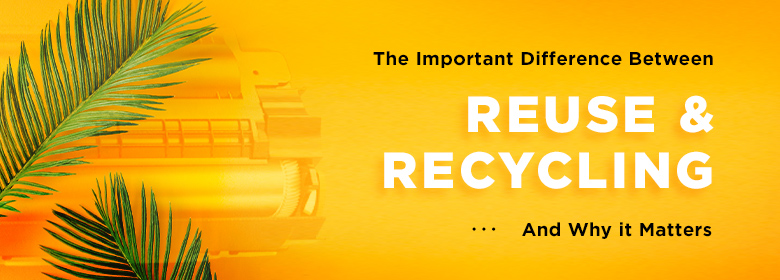
Over the past few decades there has been an increasing interest in sustainable practices — from the board room and the manufacturing floor all the way to consumer households. In fact, modern consumers are increasingly focused on purchasing products that are sustainable from companies that take an interest in the health of our planet. And while the old mantra of “Reduce, Reuse, Recycle” is still an important part of keeping our environment safer and cleaner, it is becoming clear that some sustainable practices offer more benefits and advantages than others.
Specifically, there has been a shift from targeted recycling to a more circular operational economy that allows resources needed for industrial processes to be used for as long as possible to conserve natural resources, eliminate waste, and reduce energy consumption. While recycling can still be a useful part of this process, reuse is moving to the forefront as a key sustainable practice for both consumers and businesses.
So, What IS the Difference Between Reuse and Recycling?
Many people lump reuse and recycling into the same category, in part because sometimes recycling is the first step in reusing a product or resource. But there are specific differences that make reuse a much more important part of the sustainability process. Let’s take a closer look at why:
Recycling — The Good, the Bad, and the Ugly
Recycling can be a viable way to contribute to renewable resources, as it takes less energy and resources to recycle materials for industrial use than to use virgin sources of material. However, many people don’t fully understand the intricacies of recycling, so much waste that can be recycled, simply isn’t. It is estimated that only 30% of materials that can be recycled, are.
Some recycling methods can only recover low-quality materials that have limited benefits in the marketplace, so advanced recycling technologies must be used. However, some of these technologies, such as thermo-chemical recycling, are energy intensive, which can contribute to environmental impact. To truly achieve circularity, companies must begin to rethink the flow of materials and the design of new products. That’s where reuse really shines.
Why Reuse Should be the First Choice for Sustainability
Reuse requires less energy consumption than recycling and it helps keeps materials from landfills. Reuse not only reduces the waste stream and conserves natural resources, but it also produces less pollution and requires less energy than creating new products made from virgin materials. Not using virgin materials also has another benefit — it prevents the destruction of delicate ecosystems through the decreased use of raw materials.
Reusing items helps to keep them in circulation, thus contributing more fully to a sustainable, circular economy.
How Reuse and Recycling Can Be a Powerful Combination
The best solution for a robust circular economy is a combination of recycling and reuse that can help collect and dispose of waste in a way that does not impact already overburdened landfills. Collecting recyclable materials and reusing them requires less energy than creating products using raw materials — and it conserves our precious natural resources as well. In addition, both reuse and recycling can help stimulate the economy by adding much-needed jobs in diverse areas — from rural to urban. Recycling creates ten times the jobs that traditional waste disposal does, while reuse projects create thirty times more jobs. According to a Recycling Economic Information (REI) report issued by the Environmental Protection Agency in 2020, reuse and recycling activities contributed to 681,000 jobs, $5.5 billion in tax revenue, and $37.8 billion in wages in the United States alone. That’s roughly 1.17 jobs created for every one ton of recycled materials.
Clover Imaging Group Can Help Your Company Be More Sustainable
At Clover Imaging Group, we take sustainability seriously. That it why we have combined both reuse and recycling in our sustainability programs. Through our cartridge collection and remanufactured cartridge programs we have successfully diverted 348,200,000 pounds of empty cartridges and parts from our nation’s overburdened landfills. In addition, our remanufactured cartridges use 79% fewer materials for a 51% smaller impact on the environment. Not only do we conserve 56% more natural resources through the remanufacturing of ink and toner cartridges, but we use 48% less energy in the manufacturing process. We are proud to note that the recycled content of our black and white and our color toner cartridges is 89.6%, while our inkjet cartridges boast an astounding 96.89% recycled content. And, any cartridge that cannot be reused is responsibly recycled to help keep that circular economy moving along.
The best part is that this kind of sustainability is not only good for our planet — it is also good for business. Our remanufactured ink and toner cartridges meet or exceed yield and performance of typical OEM brands with ZERO out-of-the-box failures. Plus, they can save your business up to 40% on printing costs.



 United States
United States
